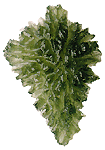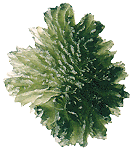

Mysterious origin
Moldavites were first described more than two hundred years ago. The first scientific report about these strange stones, appearing only in the south of the Czech Republic, was published in 1786. Moldavite, whose origin is wrapped in mystery, is connected with the fall of a huge meteorite on the Earth in the area of Central Europe. Try and imagine: a giant meteorite does not burn during its flight through the atmosphere but hits the Earth's surface at a certain angle and speed (22km/sec). In the impact its kinetic energy changes, in a fraction of a second, into thermal energy.
The meteorite explodes, and the released heat perfectly melts the original rock, which is shot up by the pressure of the explosion to a height of about 50 kilometres. The subsequent cooling of this melt on its way back to the Earth's surface gave rise to natural stones of peculiar shapes and colours.
Main localities
The locality Chlum nad Malsi
– Lodenice is the best surveyed space in terms of geological prospecting. This place seems to have the best prospects regarding the concentration of moldavites. The raw material coming from here is best fitted for cutting. The locality Besednice offering only a limited deposit of moldavites of top quality is considered unique, especially for the mentioned limitation of the deposit. The presumed area of the Besednice deposit is only 80 x 500 metres. Findings in this place are distinguished by its exceptional sculptation and that is why they are much appreciated by collectors. A detailed survey is being carried in other 10 localities (Vrabce, Nová Hospoda, Jankov, and others), where mining is supposed to begin within two years.
Chemical and physical properties
Moldavite is essentially green-coloured natural glass with a high content of silicon oxide, with amorphous vitreous structure, and hardness about 6,5 degrees of Mosh hardness scale (it can be compared to opal or chalcedony). A very specific feature of moldavites are round bubbles inside the matter which, owing to the content of rare gasses, corroborate the above-mentioned theory of their origin. The American agency for cosmic programme NASA found in examining the gaseous inclusions that the pressure of rare gasses ranges between 30 to 40 mm of Hg column, which is equivalent to the pressure of roughly 20-25 km above the Earth's surface.
Why they are popular
The man was fascinated by the charming moldavite not only because of its mysterious origin, but also because of the beauty of the shades of green colour. Their originality is given by the irreproducibility of the same shape and surface which can compare with the bark of old trees. This bizarreness – technically sculptation – was primarily created after the flight and impact of the melted matter on the Earth's surface. The wrinkled surface (sculptation) is the result of a long period when the stones were lying in fluvial deposits of gravel sand in Tertiary era. Millions of years of water and humic acid etching developed little hollows, grooves, and silky lustre. No wonder, that moldavites are today much sought-after precious stones, especially if the source of the exceptional deposits is limited.
The oldest worked moldavites go as far back as earlier Stone Age, when they were worn as amulets, mostly because of their natural appearance and colour, and because of the capacity for influencing the state of the human body which has been attributed to them since time immemorial. Ancient learned men from Babylon and Egypt, as well as astrologers in Middle Ages attributed a magic power to all green stones. Till these days the belief in their capacities is strong especially in the countries of East Asia. The fact is that moldavite removes tiredness, headaches, and is more than any other stones a fitting object for concentration exercises and meditations.
Exhibits from the Chlum (on the left) and Besednice (on the right) localities Deposits:
in Southern Bohemia at the riverside of the river Vltava = Moldau
Chemical composition: silicon glass + Al, Fe, Ca, Na, K, Mg, Ti, Mn
Astrology: protector and energiser of all sings
Chakra: heart, forehead, top of the head




Graphics & layout: ©2000 Dalibor Feuereisl - All Rights Reserved
Optimalized for Netscape Communicator 4.0 or above (800x600)